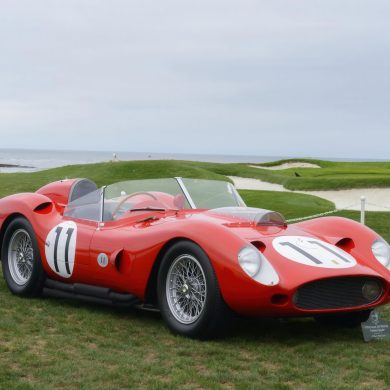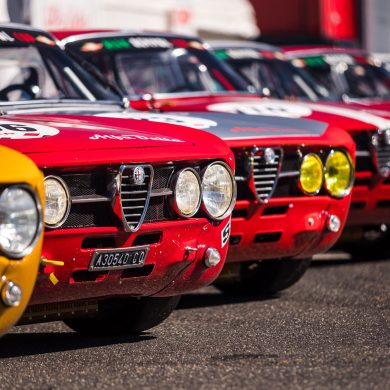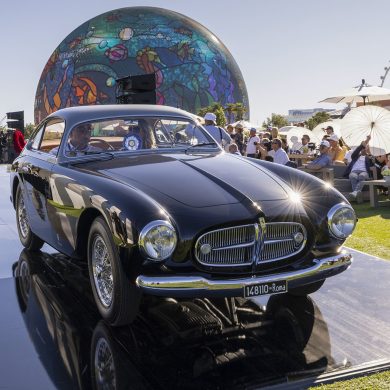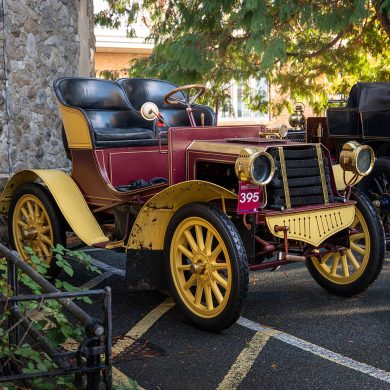Story by Raffi Minasian
Pop quiz.

The story of Chet Herbert is pure inspiration. Afflicted with Polio at age 20, Herbert spent his life building a string of record-smashers (a feat any hot-rodder of the time would have been happy to do once) over and over, never once resting on his achievements.
Following WW II Herbert opened the doors to his speed shop, grinding some of the finest camshafts for the growing world of automotive performance. In 1950 Herbert built Beast I employing a modified Knucklehead tuned to deliver 128 MPH at the dry lakes. This bike was heavily campaigned and eventually became a record-breaker at the drag strips. Beast II was the next Herbert creation, a drag race car that was also a strong competitor.
Encouraged by the success of these projects, Herbert embarked on a far more serious racing effort. A hopped up bike and dragster was one thing, but a scratch-built Bonneville Streamliner was far more ambitious. As with everything Herbert had done before, nothing about this journey would be predictable or simple.
By 1952 streamliners had become the ultimate speed weapon of choice on the salt and Herbert was ready to slice his own tracks. At the time several cars such as the Xydias & Batchelor and the Kenz Twin Ford liners were setting land speed records. These cars were built with stout frames, robust engines and slippery bodies doodled on writing tablets. But Herbert could see far more potential hidden in the development of the body construction leveraging the science of aerodynamics. Herbert made a critical decision that would forever change the sport and set a standard that remains to this day. He hired a scientist to design his Streamliner.
In 1952 something else was happening in the heart of Los Angeles. Aerospace was the hottest technology and the young guns leading the charge often moonlighted in the hot rod world. Herbert did some checking around and learned about one such engineer; Rod Schapel, a brilliant young man working as a consultant at Cal Tech’s wind tunnel. Schapel was a mechanical engineer assigned to study the behavior of airplanes under various stresses and loads. Herbert and Schapel hit it off instantly and set about to design and build a streamliner like no other based on aerodynamic computations. The plan was to build the car and have it ready to race at Bonneville in August of ’52. With only months to build the liner the team set to work quickly.
Today Rod Schapel is very much alive and still designing vehicles for speed. In a recent interview with Schapel he commented on the initial build. “What no one realizes today is at the time I was designing Beast III, I hadn’t been to Bonneville and I’d never even seen a Streamliner. Of course that didn’t matter to me. I knew what the car had to do so I designed it to be fast and stable relative to the laws of physics.”
Schapel began the project by making a 1/10th scale model formed from aluminum following clay and wood patterns. He then used the model in a series of wind tunnel tests at the recently completed Cal Tech wind tunnel. With test data in hand, they refined the shape to increase speed and stability. Such testing was extremely forward thinking in 1952 and, according to a December ’52 article in Hot Rod Magazine, these were “the first such extensive tests conducted in the U.S. on a land borne vehicle.”
Once the model’s form was finalized it was time to build the full-scale body. Here again Herbert was intent on pioneering new frontiers. The team chose what was then the space-age material of fiberglass for its lightweight and uniformed construction characteristics.
Schapel began by lofting full-sized sections of the body in his home backyard. The hand lay-up body and the molding process took approximately two months. The male mold required to build the body was such a massive structure that, in the end, Schapel’s only option to return the backyard to his family was to cut the mold up and discard it. Beast III would become one of a kind.
The final shape was not only purposeful and aggressive but was an absolute visual stunner. At 20 feet long, Beast III was fully enclosed and tapered to a bladed tail, itself nearly as long as a modern sports car. According to the President of the Society of Land Speed Racing Historians, Jim Miller, “Beast III in my mind was the greatest of the early Streamliners that ran on the salt. Herbert and Schapel really got the shape right on that one and it influenced many of the liners that followed. To me this is the all-time quintessential Streamliner.”

Herbert initially experimented with the idea of running Beast III with a modified aluminum 330 cubic inch 6-cylinder Franklin aircraft engine. When the motor exploded during dyno testing at Tony Capanna’s shop Herbert quickly discarded that notion. He briefly contemplated using a supercharged Miller engine but ultimately made the decision to go with the most potent V-8 available…the Chrysler Hemi. Truck fleet owner Dana Fuller of San Mateo, California was a friend of Herbert’s and agreed to provide the engine. Herbert heavily modified the ’51 Hemi monster and equipped it with Hilborn fuel injection and a Vertex magneto. Four individual exhaust stacks were fabricated with precision and fit to exit through each side of the body.
This was an all-out assault on speed and Herbert was uncompromising in his choice of only the highest quality components. Beast III’s equipment included a Halibrand quick-change tube axle unit with an aircraft type spot brake, 18-inch smooth cast Halibrand magnesium wheels riding on Firestone Bonneville racing tires, hand-operated brake and shift levers, and foot-operated clutch and accelerator pedals. Gear shifts were by a Ford V-8 side-shift unit with a Cook adapter.
One of the truest truisms about Salt Flats racing is “no matter how early in the year you get started, you’re always rushing to get the car ready as Speed Week approaches.” This was never truer than with the Beast III project. As time flew by, Herbert realized he needed additional manpower to finish the car in time for the meet so he called on his friends at Chrisman & Sons Garage of Compton, California.
The Chrismans turned their entire facility over to Herbert while Chrisman Sr. and sons Art and Lloyd, as well as a host of others, got down to business with the Beast. From all accounts it was a marathon effort that often seemed would never stand a chance. When it debuted in Hot Rod Magazine the article was aptly entitled “The Impossible Car That Came True”.
According to Herbert, “The building of that car was a real accomplishment. At the end we did it with volunteer labor. Some of the guys were working jobs during the day so they could only come at night. We were working around the clock 24 hours a day. I couldn’t count on who was coming so I stayed there all that time for three or four days, awake the whole time working. I got so tired that they tied me in my wheelchair with a belt to keep me from falling out.”
Miraculously the car was completed a few days after Speed Week began with Herbert and his crew driving all night to meet the salt. The crew included Art and Lloyd Chrisman, Schapel, Fuller, Howard Johansen, Harold Miller, Ed Losinski, and Roy Reed. The liner arrived on the salt on August 27 which was the fifth day of the meet. Officially entered as the “Herbert Cams Special,” the car ran as a D-Streamliner appropriately adorned with the beastly number 666.

Herbert and driver George Bentley quickly got down to business. Beast III easily achieved 182 MPH, 197 MPH and 211 MPH in its first three attempts. According to Chrisman, “Bentley missed a shift and tore the clutch out. We stayed up all night welding the clutch solid so that we could run the car with direct drive.”
The next morning Bentley didn’t show up at the salt. Chrisman said, “We put the car in line and kept waiting for George to appear. We’d get close to the front and pull out of line. We did this three or four times and then, hell, I said ‘I’ll drive the damn thing,’ which was pretty stupid because my dad warned me before I left home that he’d kick my butt if I got in that car.”
Because of the improvised direct drive configuration the team had to come up with a way to get the car going fast enough that they could start it and get it running. The solution was the use of two push cars. Three cars nose to tail left the starting line with a stock street early 50’s Chevy Coupe pushing a race prepped ’29 non-fendered roadster and Beast III. When the trio had reached 70 MPH the Chevy backed off and the roadster, car # 606, Howard Johansen’s “Howard Cams Special”, pushed Beast III to 130 MPH. From there Chrisman and the liner were off and racing on their own.
The first Chrisman run was clocked at 219 MPH and the car ran smooth and stable. According to Chrisman, “Everything was fine until I went through the last trap and it was time to slow the car down.” Chrisman recalled, “I lifted off the gas and switched the magneto off but the damn thing kept on running. I’m going well over 200 miles an hour and I suddenly realize I have no way to stop this thing. I tried the brake but it was a single Halibrand spot and it didn’t do anything. I passed the next mile marker and the salt was really soft and the tires started digging into the surface. Now I’m getting concerned. Salt is coming into the closed cockpit, first covering my feet. Before I know it I’m waist deep buried in salt and the car is still hauling ass and the mountain at the 12 mile is coming up quick. Then out of nowhere the engine starts to sputter and the car starts to slow down. I didn’t make it to that mountain but I got damn close. I later learned that because of the nitro we were running the valves were overheated and the engine was dieseling like hell.”
The team dragged the car back to the pit and learned that there was no compression left in the engine. They removed the heads and were dismayed to see that the valves were completely sucked into the valve pockets. With no spare parts on hand and with a 331 Hemi being a relatively scarce commodity in 1952, Herbert and Chrisman figured the meet was over for them. So they packed up the Beast and hauled it into town. Then another miracle happened. Chrisman said, “We were just hanging out in the hotel parking lot when a Greyhound pulls in. This six-and-a-half-foot cowboy gets off the bus, walks up to us and really gives the car a look over. The guy started asking questions and Chet told him about the tuliped valves and the fact that he had no spares and no way of getting the car racing again. The cowboy said, ‘that’s not a problem.’ It turned out that the cowboy worked at the Chrysler dealership in Salt Lake City and before we knew it we had more valves than we knew what to do with.”
Reinvigorated, the team returned to the salt the next day. Chrisman got back in Beast III and turned progressively faster runs of 224 MPH, 230 MPH and finally an amazing 235.991 MPH with a one-way best mark of 238.095 MPH. Chrisman’s herculean effort behind the wheel put him in the 200 MPH Club, at the time making him one of the first five members. It also made Beast III the fastest single engine car in America.

These achievements were astounding, particularly considering Herbert’s physical limitations, the short build schedule, and all of the mechanical problems encountered during Speed Week. Chrisman has driven a lot of sophisticated machinery in his 50-plus year racing career but he’s never gone faster than he did in 1952 in Beast III. Schapel, however, was not surprised by how well the car did; “It’s all about aerodynamics. I designed that car and built that body to be fast and stable and that’s just what it did.”
Schapel’s scientific approach to Beast III changed the way people thought about Streamliners but he was just getting started. A few years later Schapel designed The Spirit of America for Craig Breedlove. This Schapel design became the world’s fastest car in August of ‘63 at 407.44 MPH. The following year Schapel’s rocket bettered the world record at 468.72 MPH, before shattering it again at 526.28 MPH.
Following the ’52 Bonneville event, Herbert partnered with Dana Fuller, who ran the reconfigured Streamliner with a 425 cubic inch 6-71 GMC diesel engine equipped with an experimental cylinder head and two superchargers. Fuller drove the car (# 671) to two diesel FIA world records at Bonneville in ‘53.
Fuller retired the car sometime in the mid 50s and from there it sat idle for nearly fifty years. Land speed racer Ed Hegarty ultimately bought it from Fuller’s family in 2002 with the plan of getting it running. But the Beast remained idle.
In early 2009 the car quietly came to the attention of hot rod expert Dave Crouse of Custom Auto in Loveland, Colorado. According to Crouse, “When I first saw the car I couldn’t believe my eyes. It was incredibly well preserved which is extremely unusual for an early 50’s Streamliner. This car changed everything in Streamliners and in my mind is one of the most important land speed cars of all time.”
Dr. Mark Brinker of Houston, Texas, a patron of Crouse’s restoration shop and himself a Bonneville record holder, couldn’t resist the chance to restore Beast III and instantly bought the project. Brinker has long been captivated by the legend of Beast III and considers this project a wonderful opportunity to honor Chet Herbert and his magnificent machine.
The car has been undergoing a world class restoration at Custom Auto and will make its first public appearance in 55 years at this year’s Pebble Beach Concours D’Elegance where it will compete in the Hot Rod Class. Chrisman and Schapel have been heavily consulting on the project and will be at Pebble to see the car on the 18th fairway.




Following Pebble Beach, the car has been invited to be on display at The Petersen Automotive Museum in Los Angeles until February 2011. After that, Brinker plans on racing the car at the Texas Mile speed event in Goliad, Texas.
But like many car stories there is yet one more piece in this already stunning journey. Brinker grew up with a sister afflicted with Cerebral Palsy. Wheelchairs and the strength of those within them have been very familiar to him. His sister’s courage had such a profound impact on Brinker that he dedicated his life to the practice of orthopedic surgery specializing in complex fractures and their late stage complications. More than mending broken bones, Brinker rebuilds the lives of his patients who have been stricken with severe mobility challenges; patients like Chet Herbert.
When Brinker heard about the Streamliner, undisturbed since the mid-50s, he knew this was the right project for him. Shortly after restoration began, Brinker commented frankly about his emotional connection to the project. “Chet Herbert refused to allow his disability to encumber his life much like my sister and so many others like her, in their daily lives. The December 1952 Hot Rod Magazine cover showing Chet working on Beast III from his wheelchair must have inspired an entire generation to do things beyond self-imposed limits, to see ahead of frustration, and build something beautiful. I felt compelled to see that vision restored.”
The legendary efforts of this speed pioneer, the painstaking restoration and the passion of a driven collector eager to tell this heartfelt story are celebrated in this revelation of speed and beauty. The spirit and determination of a man who refused to accept boundaries, delivered not only in the record books, but revealed a stunning beauty within that same object. Few mechanical creations have succeeded at both levels; few men are brave enough to blend their soul into their machines. In this regard, history treats us to a journey beyond the victory on the salt, it is a triumph of the human spirit.
Raffi Minasian is an Automobile Designer and Historian, and Pebble Beach Class Winner in 1994.










Beautiful story. Very well done.
Congratulations Mark! Well done to bring this fantastic piece of American land speed/salt racing history to life again! I can’t wait to see her in person at Pebble this year.
Lovely piece – touching and a great read.
Great story , but I kinda lke it “as found”
I can remember seeing the “Hot Rod Magazine” cover photo when I was a kid and being amazed that the guy was in a wheelchair once I finally noticed it….
Great news Mark!
Be sure to shoot several pics of the Beast in the event. Good luck!
Great story. I am a friend and fan of Dave Crouse and his group at Custom Auto. Can’t wait to see the car at pebble beach.
What a great story. The Redhead is another that’s still around and the Beast looks like a cousin or something. Also some resemblance to the Herda-Cagle liner from the side-rear.
Unless that single spot brake has been upgraded, before running the Texas Mile go down and walk the area at the end of the runway to see how much you want to rely on that brake to get you stopped.
Thanks for bringing it back.
Wow, Doug your dad impresses me more and more each time I read another article about him! What a legend!
This story as good as it may sound, is not true, I knew Dana Fuller personally and this Bonneville Streamliner was Designed, Built and Driven by him personally.. Dana was a genius both in the field of electrical and mechanical fields with no formal education, he quit school at 16 and became a jouneyman electrician. He came from very wealthy parents who were both pilots and they had their own hanger at San Francisco Airport. The family owned Fuller Paints Co.of San Francisco. Dana was a fan of GMC 671 diesels and incorporated a multitude of his ideas into vehicles he built with these ideas and got over 300 HP on dyno testing. He passed away after suffering a stroke tragically and the the Streamliner was inherented by his long time friend Ed Grachi of San Francisco, CA. This is the true story and I knew both Dana and Ed for about 20 years, so I can speak with authority and honesty. He truly was an amazing man Sincerely Tom Dunlap
I see several comments directed at “Mark,” but no mention of a Mark in the article. Is that Dr. Mark Brinker from Houston?